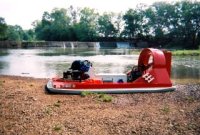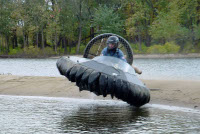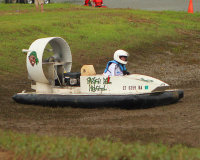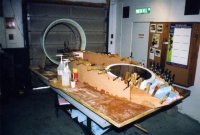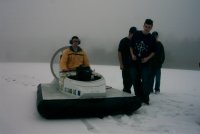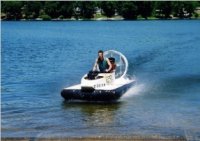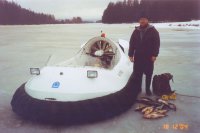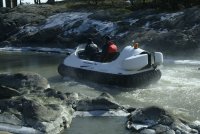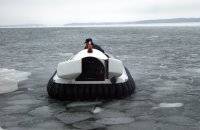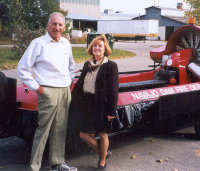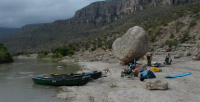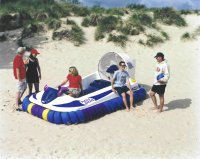
Home
Events
News Center
Newsletter
Downloads
Forum
Links
Contacts
World Hovercraft Organization > HoverWorld Insider > March 2008
|
In this issue:
Upcoming Hovercraft Events: April 2008: Elk River Cruise 12 April – Prospect, Tennessee USA Stephen Pepper, a local host of the Hoverclub of America, will sponsor a 12 April cruise down the scenic Elk River. The 80 mile trip is based on a trip Pepper made in August of 2007 during which he cruised down the Elk River from Highway 127 to Harms Dam near Fayetteville Tennessee. The cruise will cover much the same ground that Pepper covered last year. With several proposed
breaks, the cruise will last most of the day. Pepper explains that if time permits, there are several
branches of the river worth exploring. Camping and hotel accommodations are available at a possible
discount rate. May 2008: Hoosier Hovercraft Championship and Wabash River Cruise 16-18 May – Terre Haute, Indiana USA
The first Hoverclub of America rally of the year, the 2008 Hoosier Hovercraft Championship, is coming in May to America’s original hovercrafting city, Terre Haute, Indiana. This rally is one of the premier hovercraft racing events in America. Arrival and setup will begin in the afternoon on Friday 16 May, 2008. Onsite camping is available, and nearby Terre Haute offers several hotel options, including a new Hilton Garden Inn located in downtown Terre Haute, minutes from the race site. Practice and racing will take place on Saturday, followed by an awards banquet. Racing fees are $50 USD for the first formula and $20 USD for each additional formula, and the Hoverclub offers a 10%-20% discount for online registration prior to 10 May. On Sunday, the scenic Wabash River Cruise with lunch at Turkey Run State Park, always a highlight of the event, will follow a new course this year, which promises to be more challenging than in previous years. Several different launch points offer participants a choice of different trip lengths. For complete information on this popular event, see the Hoverclub of America’s Hoosier Hovercraft Championship brochure.
August 2008: World Hovercraft Championship 20-24 August – Flottsbro, Sweden Flottsbro, Sweden is gearing up to host the 2008 World Hovercraft Championship this 20-24 August. The official WHC2008 web site has been launched, with detailed information including the schedule of events and views of the racing area. Plan to arrive after 10am on Monday 18 August, as this is the earliest trailers will be allowed in the paddock. Time trials for all formulas will be held on Wednesday 20 August and Thursday 21 August, and racing will extend from Friday 22 August through Sunday 24 August. Flottsbro is a recreational area located in the south of Stockholm County, Sweden, and offers full service camping or rental cottages. The shores of Lake Alby form the beach portion of the area; in winter the spot is home to the largest ski resort in Stockholm. With mountain bike trails, disk golf, canoeing and traditional Swedish kubb, a lawn game involving wooden blocks, Flottsbro offers several options for relaxing entertainment. The Parish Hill High School DiscoverHover program, Chaplin, Connecticut, USA Jim Benini, the founding instructor of Parish Hill High School’s hovercraft building program, has established a curriculum that has inspired his students and community since 2001. His success in generating support from the school system, attracting community attention, and arousing student excitement has made the hovercraft program at Parish Hill an exceptional one. Jim Benini shares with HoverWorld Insider readers his insights on creating a successful school hovercraft program …
In 2001, Benini approached the principal of rural Connecticut’s Parish Hill High School with a unique idea. He wanted to give the students in his “Principles of Technology” class a chance to apply their studies to the practical experience of building a hovercraft. His plan was to acquire a Universal Hovercraft 10F and use donated or easily purchased materials to complete the hovercraft. Described by Benini as “a very understanding and forward thinking man,” the principal gave his permission to start the project. “When I explained what my class was going to do, he was very curious, and from that point on would ‘drop by’ twice each week to see progress on the craft,” states Benini. This easy permission allowed this first class to generate the excitement that has carried through the subsequent years of Benini’s hovercraft-in-schools experience. The students who worked on the initial hovercraft were so involved that it became more of an extracurricular activity than a class project though, originally, they were skeptical that the hovercraft could be completed and would be able to fly.
“On the last day of school, we took the unpainted craft outside to see if the donated engine would run. It did, and the craft wanted to fly!” Benini’s description of his students’ enthusiasm for the hovercraft becomes even more apparent as he describes how the students remained involved with the project through the summer months. “School ended and summer officially began, but there were 12 students with me on the baseball field learning how to fly at 3:30 that day! We painted the craft and flew it on the Connecticut River that August at the Connecticut hover-in.” Benini’s principal quickly recognized the students’ support for the project. “In September, my principal approached me in the hall and mentioned he had numerous phone calls about the project from parents. He paused, smiled, and asked, “You’re going to build another one this year, aren’t you?” In order to gain support for his project, Benini created a video presentation for the Board of Education. After his presentation, the Board was quick to announce their cooperation. They offered more than simple acceptance of the idea, however; the Board was quite eager to see the program in action. “When do we get to fly it?!” they exclaimed to Benini. The Board has never wavered in their support, says Benini, “Especially since we started competing at Hoverallies.” With the program continuing year after year, financial support was needed, for both construction materials and hoverally attendance. The Board has supplied funds for hoverally transportation expenses, Benini explains, but the primary funding source for his hovercraft program come from the program itself: “We’ve been selling off our crafts after we race them in Ohio to fund the next craft.” This idea of using the class project to pay for the project is an innovative one, which has helped Benini keep his program hovering.
Benini has attracted significant attention to not only to his school and students, but also to the value of school hovercraft programs. He has generously offered his expertise to other schools by writing Curriculum Guides for the World Hovercraft Organization’s DiscoverHover program. “Every once in awhile I get an email from a school or a teacher with questions, and I’m glad I can help them,” he says. His support and enthusiasm for other school hovercraft programs is an asset to the overall hovercraft community. By introducing the idea of the hovercraft to students, Benini is not only giving them the hands-on experience of applying their learning in practical ways, he is also ensuring that the hovercraft is embraced by a new generation. For the students, the real excitement is in racing their hovercraft. Each year, the hovercraft builders race at the Hoverclub of America National Rally. Benini is proud to announce, “My students live to build, fly, practice and race.” Attributing the students’ eagerness to the unique nature of hovercraft racing and his school’s rural setting, Benini explains that his students are not concerned with winning at the races. “They know we probably aren’t going to finish in the top three spots, but for them the thrill is the actual racing and seeing how well they can do.” The fact that the races are national also adds a degree of prestige to their participation.
Benini and his students have enjoyed the attention of the media. They have been featured numerous times on local and national television since 2001, including a Saturday morning program that interviewed the student teams and taped them flying their hovercraft in Hartford, Connecticut, and a Public Broadcasting Service (PBS) broadcast about the hovercraft program in October 2007. The hovercraft group also appears regularly in parades. With all the excitement over the Parish Hill Program it is easy to see why Benini felt that writing a shared curriculum for DiscoverHover was an important step. A hovercraft program can provide an outlet for schools to increase their students’ involvement and foster a community’s interest in its schools. Benini’s success exhibits how a flourishing school hovercraft program is not only attainable, but is also a huge amount of fun. Life as a Hovercraft Dealer: Markku Huvinen, Finland One way for a company to expand globally is through a mutual relationship with a dealer. A dealership opportunity benefits both parties, and offers a company a way to reach a larger customer base while developing a working relationship with another enthusiast in its area of interest. Markku Huvinen, President of Craftima Oy in Helsinki, Finland, has found his experience as a dealer for Neoteric Hovercraft Inc. both enjoyable and challenging. In an interview, Huvinen gives HoverWorld Insider readers an inside look into managing a dealership and meeting the demand for evolving applications for hovercraft. When did you become a dealer? I researched for a year (2003) then I started in 2004.
How has your business expanded since then? It depends on how much I can deliver, because as many as I can have, I’ll sell them. I’m working with a backlog of orders. If this were my main job then I’d have to take a big risk and order 20 units a year. Business started slow and it has increased quite stably, and at the same time it has expanded from the private to the official authorities. I’ve done very little marketing, just one exhibition a year, The Helsinki International Boat Show. In fact, that’s in a very bad time for me because it’s in the middle of winter. They order something; they have to wait 8 months. And hovercraft are not used in the summertime in Finland, only in winter. Who are your customers? So far customers have been mainly those who live on the archipelago or they have summer cottages on the archipelago. These people can use their home or summer cottage only in the summer because it is so icy. They have to cross frozen lakes or sea, so they can’t go there. They want to go to their homes other times as well, especially in springtime. Hovercraft are the only way to get there. Other customers are ice fisherman; ice fishing is a big hobby in Finland and hovercraft extend their fishing season. In Finland, are regulations different for hovercraft than snowmobiles? Yes and no. As I have told all my customers, almost everything is yes and no, or unclear. If you ask some police officers what a hovercraft is, they will tell you that they don’t know. That makes it quite difficult, for example, for insurance. There are only 2-3 companies who provide insurance for hovercraft. Now there is a new regulation for 2-stroke engines and I was asking our authorities whether the hovercraft are under these regulations. They came back to me, and said no. Hovercraft are some sort of strange thing to authorities. To be honest, the hovercraft needs its own category. For example, when I buy a hovercraft here, the custom tax is sometimes 10%, sometimes 1.5%. It depends who is checking the papers. Tell me about the environment in your area. In fact, hardly anyone uses hovercraft in rivers. For the lakes and sea, there are dangerous places where you can drive a snowmobile through thin ice. Many times a customer has had this happen and that makes a hovercraft easy to sell. Sometimes the ice is so hard and thick people can drive cars on the lake or sea, but some winters are very mild. The challenge is to make the hovercraft a year round vehicle, but it will take time. First I have to sell some number so customers will ask themselves why they can’t use the hovercraft in the summer. In fact, customers are my marketing. I don’t have so much money to put together all kinds of advertising.
You’re doing no marketing in Finland besides the International Boat Show? Of course I have a web site, but that’s all. On the other hand, TV companies and magazines have been very interested. They have made some stories. When I sold one to rescue people it was on TV three times, also in the news and in magazines. This is the cheapest way to advertise. Every year we have been on TV once or twice, and in some sort of magazines. Where are most of your customers learning about you? This exhibition was the biggest one in the whole country, 90,000 people came. So I have learned that I have to keep all my emails over these few years. Customers are looking, but it will take one or two years. What has been your biggest challenge in building your business? That’s difficult to say. One thing is: first two years when I was in exhibition, there were a lot of people who were just ‘kicking some skirts.’ They explained that they have this kind of unit but it won’t work and things like that. This made them against the whole idea. But they are still there every year in exhibition and they have an understanding that there might be something behind hovercraft. So those attitudes, which have been against, can be difficult to handle. Are you able to demonstrate the craft at the boat show? Unfortunately not, because it’s inside. First two years after the exhibition, I have a lot of demos. This year, not anymore. The people have seen the craft used by the authorities, that is a big screen. What has been your most satisfying experience since you’ve become a dealer? Perhaps it’s this: We made three different videos (in very bad conditions) for the Finnish Maritime Authorities. Finally they bought a hovercraft and I was very satisfied with that. Then they made a video and gave it to me and said ‘you can use that.’ I realized that, okay, they have really accepted this. It gave me the impression that they are really happy with the craft. Of course, there are some other departments of that company who bought later, but this was perhaps my most impressive moment when I look back on it. It’s normally customers who say ‘thank you very much’ after sales, but this was the authorities who said ‘hovercraft work and we are saving during one winter its cost’. How was the timing of your venture? Was it the right time to become a dealer? If the product had been as it is now, let’s say 10 years ago, that would have been a good time. There is a market in Finland, there has always been a market and somehow it’s reasonably good more and more as an idea. If you look at the history there is one Finnish guy who has been doing research on hovercraft. I can remember many of the older Finnish people; they thought he’s the man who made the first hovercraft. That’s not true. As I said, 10 years ago if hovercraft was what it is today, I would be much younger.
What has been the most difficult aspect of starting a hovercraft dealership? Perhaps it is to understand the background and then translate it; most people are not very technical. This is not a mass market; this is a minority group in that sense. Hovercraft will give them more freedom in their free time or, in the rescue business, it helps a lot in cost saving. How did you first become interested in hovercraft? I have an island, in fact, my parents have an island, but they don’t use it anymore. They’re quite old. I like to be there in the wintertime also to extend the season. I was thinking about how to get there. Snowmobile in the south is useless. The distance from the mainland to the island is 11 km. The first five you can drive by car over the ice and it will still hold. I never know when it’s too thin. I’ve seen hydrocopters quite a lot; they are very noisy, so no way. So I was thinking, a hovercraft maybe. Then I started researching on the Internet. What would you say to someone who is considering becoming a hovercraft dealer? Take care of legal issues. As I told a friend in Finland, who was very, very interested, it’s not an easy business. You have to take care of all legal aspects and all that requires. There are a lot of rules you have to check and so on. This is true for all businesses. Do you still enjoy going out in a hovercraft just for fun? Do you even have time? Yes. When we have a demo, sometimes I go further. And sometimes I go with my family to our summer cottage. Hugh Firminger, Hovertechnics, Inc., Michigan, USA On 5 October 2007, Hovertechnics, Inc. of Eau Claire, Michigan closed to mourn the passing of their co-founder Hugh Firminger. With savvy business strategies, Firminger cultivated Hovertechnics into the strong company the business has become today. Known for constantly reinventing their products to stay on top of the ever-evolving hovercraft demand, Hovertechnics continues to honor Firminger’s strong background in marketing and business management.
Born in London, Firminger began his work in mechanical engineering and business with his entrance to the British Army during World War II, serving in various capacities: parachute operations in the Special Air Services; mechanical school instructor with the Royal Armored Corps; and a translator in Germany for the British Military Intelligence. His diverse military background gave Firminger a broad base of knowledge in both mechanics and marketing. His work in Intelligence especially equipped him for the sometimes cutthroat world of business. With experience behind enemy lines, no obstacle was too large to prevent Firminger from pursuing his goals. After leaving the military, Firminger held a series of positions for several companies and gained further experience in marketing, sales and leadership. Beginning as a European Sales Representative for Dexion Ltd. in his hometown of London, Firminger immersed himself into marketing, as he did in later positions with other firms. In 1955, Firminger moved to Trinidad to become Sales Manager of the Engineering Division for Masion and Co. Ltd. From 1958 to 1961, he held several positions, including Engineering Division Sales Director for Sandback, Eckel and Co. of Trinidad and District Marketing Manager for Clark International Marketing, S.A. in Brussels Belgium. After his promotion to Vice President of Marketing for Clark International, Firminger moved to the United States, where he later served as Marketing Manager and Vice President of Paccar International Inc. in Seattle, Washington and Vice President of Oshkosh Truck Corporation in Wisconsin. Finally, Firminger was hired by the State of Michigan to recruit job-creating manufacturing operations in Brussels, Belgium. He settled in Michigan, where he founded his own company, Hovertechnics, Inc. With his history of job change, self-employment offered stability to Firminger; he needed only to find the right product and determine his customer base. While in Brussels, Firminger had seen a television program about the UK’s BBV Hovercraft and owner Bill Baker. Firminger contacted Baker to discuss the possibility of an American based operation selling commercial and recreational hovercraft. The two collaborated for a time, finally resulting in Firminger striking off alone to develop plans for his own hovercraft from Baker’s BBV 2 hovercraft. After enlisting the aid of several experts for engineering modifications needed to alter the BBV2 hovercraft for the US market, Firminger and his wife Hedda established Hovertechnics Inc., with their initial model, the Hoverstar. After several moves of their manufacturing operation, the company settled in Eau Claire, Michigan where it remains today. Hugh’s marketing background drove Hovertechnics to continue the evolution of their product and to offer a wide selection of options for their hovercraft. Wishing to appeal to a wider customer base, Hovertechnics eventually developed thirteen models. Firminger dedicated himself to marketing his new company, traveling long distances to demonstrate his craft and train customers in proper hovercraft operation. His hobby, photography, proved to be a useful marketing tool and Firminger took many of the promotional photographs of his hovercraft. Firminger relied upon his marketing experience and steadfast focus to build his company. From the beginning, he opted for a business model that would subcontract as much manufacturing as possible, leaving Hovertechnics personnel to focus on assembly only. His company emphasized direct sales and was very selective in advertising. Firminger believed that the amateur builders, hobbyists and Hoverclub members were not a sizable market, so little effort was made to support such organizations. Instead, he used hoverclubs for PR purposes. When Scat Hovercraft began to develop the rescue hovercraft market, Firminger took the initiative to ride this wave as well. He continued to work the rescue market long after Scat dissolved in bankruptcy. Later, Hammacher Schlemmer of New York featured Hovertechnics’ products for many years. In another marketing tactic, Hovertechnics’ hovercraft were given away on the Price is Right TV program. Though the company had a number of notable customers, including various sheiks, the American presidential hopeful Ross Perot was perhaps one of Hovertechnics’ most well-known customers. After Firminger’s retirement in 2006, Hovertechnics continued to remain a strong and innovative competitor in the hovercraft market. His legacy lives on; his company, now operated by his wife, Hedda, continues today as one of the largest and more well-respected manufacturers in the hovercraft industry.
Big Bend National Park: Hovercraft River Rescues The Rio Grande River forms a 118-mile boundary for the 801,000-acre Big Bend National Park of southwest Texas. Beyond the park, the river continues to wind its often unpredictable way into another park, the Rio Grande Wild and Scenic Park. Each year, thousands of people visit these attractions. The two parks combined offer 245 miles of remote river access for rafting and canoeing, not all of which is supervised at all times by guides or park rangers.
While this uncultivated wilderness may sound like the perfect getaway for some, for the river rangers of the Big Bend National Park the river country of southwest Texas is a place of work and rescue. Since 2002, the river rangers have relied on a hovercraft for their demanding rescue operations. The duties of a river ranger focus on two responsibilities: visitor safety and resource protection. The hovercraft has proven its value in both areas, even when sometimes pushed out of its typical rescue scenario. The unpredictable nature of the Rio Grande makes responding to calls for help an urgent obligation. Typical calls involve visitors who have been stranded, lost, or much worse. In the spring of 2007, the river rangers received a call reporting a body in the river. As the water was low, the hovercraft was needed for body recovery. Damaged boats can often be the reason visitors are stranded. During low water operations, the hovercraft is the key piece of response equipment. The river volume can bottom out at levels less than 200 cubic feet per second. When jet boats and other devices cannot be used to reach those stranded, the Big Bend hovercraft has proven itself well suited to this work. In resource protection, the most common function of the river rangers is to prevent destruction caused by exotic plants. Patrols will spend a week clearing exotic cane and tamarisk from sections of the park, often resorting to fire to burn out the infestation. Landing and access sites are particular targets for this sort of clearing. While a hovercraft may not typically be considered the prime tool for clearing a stretch of land with controlled fire, the river rangers of the Big Bend National Park have used their hovercraft for just that — with impressively successful results. In June 2007, the river rangers participated in a three-day burn of over 700 acres of land, called the Sublet Prescribed Burn. The group had two goals: eliminate a large patch of exotic tamarisk from the river’s edge and stop the fire from jumping the river and spreading further into the park or into Mexico, where it would be difficult to contain. The rangers were assisted by the Wildland Firefighters to start and contain the fires. River ranger Michael Ryan was assigned to support a crew of firefighters with a Mark 3 high performance pump and 300-400 ft of fire hose. “I used our hovercraft to move the pump up and down the river to locations where the crew was fighting spot fires on the Mexican side of the river,” he states. Often actively repressing the fire, Ryan’s section of the operation was quite effective. “At one point we just strapped the pump to the backseat and pumped right from the hovercraft.” While not in use to assist the direct fire-fighting crews, Ryan used the Big Bend hovercraft for recon missions up and down the river, searching for areas where the fire had begun to escape from control. The craft was also used to move food and drinking water to the crews spread across and along the length of the river. Ryan describes his favorite part of using the Big Bend hovercraft during the Sublet Burn: “The best part of the operation was when I took the firing boss down the river so that he could ‘fire off’ a section of cane and tamarisk that was difficult to reach by land. He used a gun to launch ignition fuses. The firefighters call it a sausage gun because the rounds look like big sausages, but they burn very hot. After four or five were launched into the brush we have 30 ft flame lengths along the river. I was afraid my hovercraft was going to melt from the heat.” Ryan’s hovercraft did not melt, and he projects that the machine will be used in future fire clears on the river. From fighting fires to rescuing stranded visitors, the hovercraft has proved itself to be a vital addition to the Big Bend National Park river rangers’ arsenal of rescue equipment. Visit the website of the Big Bend National Park for more information on visiting the park and the Rio Grande backcountry.
Hov Pod, Southampton, UK Southampton, the largest city on the south coast of England, has held a primary position in the maritime achievements of the United Kingdom. As a major port town, it has been a staging ground for innovations that have revolutionized the world of transportation: the RMS Titanic, the Supermarine Spitfire, and Christopher Cockerell’s hovercraft.
Located in Southampton, Hov Pod Hovercraft markets their product to the leisure hovercraft enthusiast. Peter Ward, the founder of Hov Pod, originally explored flight through the more extreme outlet of hang gliding. A frightening accident, resulting in a broken leg, pushed Ward a little closer to the ground. Unable to give up on the feeling of flight, Ward wondered whether the hovercraft could offer the thrills of hang gliding without the danger. The marine engineer began to explore hovercraft and was soon convinced of their worth. He wondered, however, at the hovercraft’s lack of popularity with the average water aficionado. He felt that the majority were built by hovercraft racing enthusiasts. Since the design objectives between a racing hovercraft and a leisure hovercraft differed drastically, Ward wanted to create a simple but well designed and safety oriented hovercraft for the average person. Mike Glanville, Hov Pod’s marketing director, explains that from the engine to the exterior, their craft are designed with the consumer in mind. A single Rotax 52hp engine powers each craft, allowing for an easy operation and easy shutdown. The size of the engine ensures that there is enough power behind the hovercraft to reach a speed of 45mph with three adults aboard. The craft has several guards against collision. Double skin foam sandwich floor and side plates along with separate front and rear mesh guarding keep the craft reasonably safe during impact and when encountering loose objects in the water. A segmented skirt design allows the craft to puncture several sections of skirting while still staying aloft. Both the battery and electrical circuits are fitted with safety devices to be triggered in case work on the electrical systems is required. On the hovercraft, the battery can be disconnected from the system to stop electrical flow. Also, circuit breakers reduce the need to replace parts in the electrical system due to system overload. Hov Pod did not attempt to equip their craft with a reversing mechanism. Glanville states that instead, they developed a well-balanced hovercraft capable of stopping in a straight line and responsive even in a tight turn. The company strives to offer a new generation of machine, with a durable simplicity they believe is often unavailable from other producers. They say their customers want a machine that will be reliable, yet fun to pilot, but safety and ease of use are just as important. Glanville says the Hov Pod customer doesn’t want to mess with building a hovercraft of their own; they would rather have a hovercraft ready for action as soon as they receive it. To reach this customer, Hov Pod uses an atypical marketing approach. Rather than relying on advertising and dealer demos, Hov Pod uses a grassroots approach, producing videos for their own website, as well as free access Internet sites such as YouTube and other dealer websites. The company has also welcomed directors of television documentaries. Once attention is gained via the Internet, Hov Pod has set up dealers and companies to demo their craft, and they also use several dealers who rent Hov Pods for occasional use. “The sheer sense of freedom you get flying at speed barely above the surface is not easy to describe,” states Mike Glanville. Attention Hovercraft Manufacturers: To have your company news published in HoverWorld Insider, simply email it to Insider@worldhovercraft.org. …………………………………………………………………………………………………………………………… Subscribe to HoverWorld Insider HoverWorld Insider is published by the
World Hovercraft Organization. All rights reserved. |
|||||||||||||||||||||||||||||||||||||||||||
Home | Events | News Center | Newsletter | Downloads | Links | Contacts

